One week until California decides the fate of rooftop solar

- Share via
This is the Dec. 8, 2022, edition of Boiling Point, a weekly newsletter about climate change and the environment in California and the American West. Sign up here to get it in your inbox.
When California announced plans last month to reduce incentive payments for rooftop solar power, I wrote that monopoly utility companies had pushed them to do so — in part because rooftop solar undercuts the industry’s lucrative business model.
Pedro Pizarro — chief executive of Edison International, parent company of Southern California Edison — objected to my choice of words.
In a letter to the editor, Pizarro wrote that my coverage “propagates the solar industry version of the ‘big lie’ that the growth of rooftop solar in California hurts the business model of investor-owned utilities.” Solar companies, he suggested, were the ones whose profits were actually at stake.
It’s a bold claim. So I sat down with him at his office in Rosemead to put it to the test.
Pizarro told me Edison’s years-long campaign to slash rooftop solar incentives “has nothing at all to do with utility profits.” He noted that his company’s revenues — like those of Pacific Gas & Electric and San Diego Gas & Electric — are “decoupled” from electricity sales, meaning the utility doesn’t make more money if it sells more electricity.
Instead, Edison, PG&E and SDG&E make money by building power lines and other infrastructure, and charging customers a profit margin of about 10% on those expenditures — a return on equity guaranteed by regulators.
Edison customers, meanwhile, are paying billions of dollars a year in subsidies to homes and businesses with rooftop solar panels — subsidies that can account for 10% or more of customer electric bills, Pizarro said. And those subsidies largely support wealthier people who can afford solar, at the expense of lower-income people who can’t.
“We think some level of subsidy is absolutely appropriate,” Pizarro said. “But it’s just such a massive transfer of wealth.”
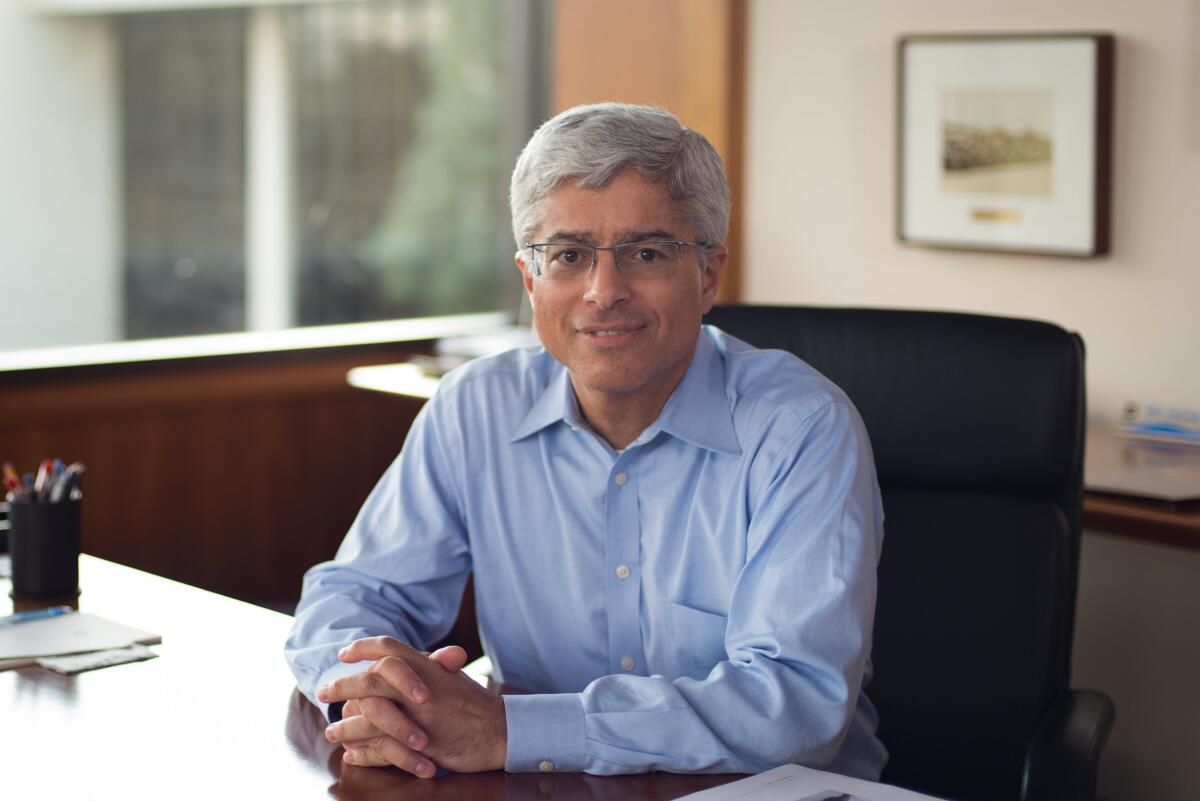
Does his argument hold up to serious scrutiny? I’ll try to answer that question.
But first, let’s take a look at what’s been proposed by the California Public Utilities Commission and how it might affect solar.
The agency wants to overhaul a program called net metering, in which Edison, PG&E and SDG&E are required to pay homes and businesses for solar energy they generate during times of day when they don’t need it all themselves. The program has incentivized more than 1.5 million utility customers to go solar, by helping them make back their up-front investment — and ultimately save money — through lower electric bills.
It’s not just utility companies saying net metering offers an unfair subsidy. Prominent consumer watchdog groups and a handful of environmental nonprofits, including the Natural Resources Defense Council, have also urged the state to reduce payment rates for rooftop solar power — in part because electricity from large solar farms is cheaper.
After years of debate, the Public Utilities Commission heeded those calls last month. Commission staff issued a plan that’s more favorable to solar installers than a previous proposal, but which the solar industry says would still amount to a 65% drop in average payment rates to Edison customers for the solar they generate — and even bigger drop-offs for PG&E and SDG&E customers.
A vote is scheduled for Dec. 15.
“This is a recipe for crushing solar,” said Bernadette Del Chiaro, executive director of the California Solar & Storage Assn.
Del Chiaro told me she and her trade group’s member companies can live with incentive payments falling over time — but more slowly than state officials envision. She thinks the five-year “glide path” laid out by the commission — during which payment rates would decline year by year before leveling out — should be extended to eight years, with much more gradual reductions.
Commission staff say their plan would encourage homes and businesses to install batteries with their solar panels.
Although the plan would reduce the average rates that utilities must pay for solar, it would increase those rates during certain times, especially summer evenings. The result would be greater financial benefits for solar customers who use batteries to store electricity they generate during the afternoon, then supply it to the larger power grid after the sun goes down.
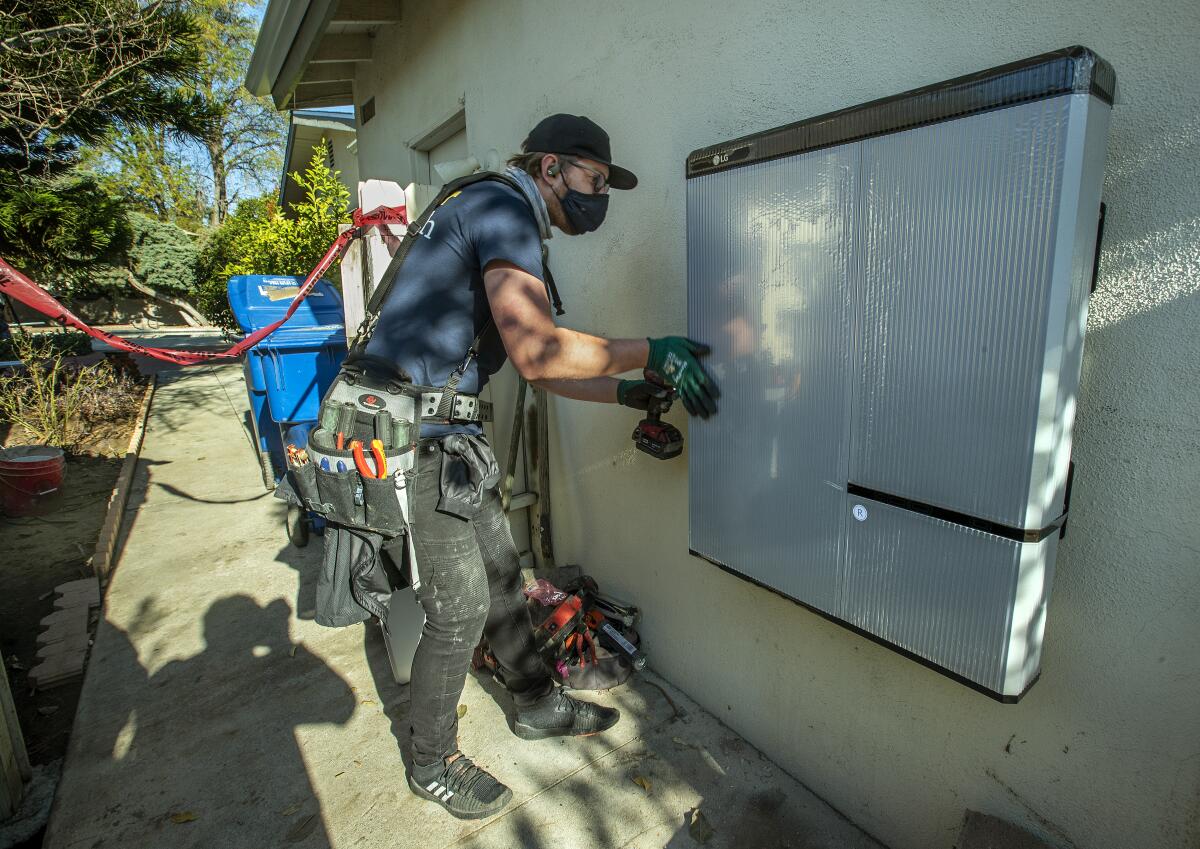
In theory, it’s a win-win-win — California would have an easier time keeping the lights on during heat waves, utility companies wouldn’t have to buy as much polluting gas-fired electricity, and more homes would be prepared to withstand blackouts.
But Del Chiaro is convinced the commission’s plan would backfire. The main problem, she said, is that lithium-ion batteries are still a relatively nascent technology, with higher costs than solar panels. Just 14% of California homes and businesses that installed solar over the last year splurged for storage, too — a higher rate than anywhere else in the country but still far from 100%.
Solar installation companies are working feverishly to pivot to solar-plus-storage. But Del Chiaro said many of those companies — most of them small businesses — would have a hellish time adjusting to the new rules without a longer glide path.
“You can’t just make drastic changes overnight without there being a lot of dead bodies along the way,” she said.
By the trade group’s calculation, the “payback period” for solar paired with batteries — the number of years it takes for a home to make back its upfront investment, typically in the $30,000 range — would increase under the new rules to about nine years for Edison customers, up from about 7.5 years today. That could make a serious dent in installation rates, companies say.
“This isn’t going to accelerate the adoption of solar and storage. It’s going to make everything more expensive,” Del Chiaro said.
The Public Utilities Commission offered slightly rosier numbers. But agency staff still estimate the payback period for new solar-plus-storage systems would rise slightly if its decision is approved, for customers of all three monopoly utilities.
The outlook could be even worse for businesses, farms, schools and other nonresidential utility customers who want to go solar under the new rules. They wouldn’t have any glide path, with payment rates bottoming out almost immediately.
Many clean energy advocates are furious with the commission, whose five voting members are appointed by Gov. Gavin Newsom. A coalition backed by the solar industry and hundreds of environmental groups held rallies across the state last week, urging the agency to change course. These activists tend to see rooftop solar as a crucial tool not only for combating the climate crisis, but also for taking power out of the hands of massive investor-owned utilities — and giving it to the people.
All of which brings us back to Pizarro, the Edison chief executive.
Pizarro’s company wants to see lots of solar panels installed in California, he told me — at large solar farms in the desert, and on rooftops. Edison estimates the state will need 80 gigawatts of new capacity from large solar and wind farms to reach 100% clean energy by 2045 — along with 30 gigawatts of smaller-scale solar at homes and businesses, still an enormous volume.
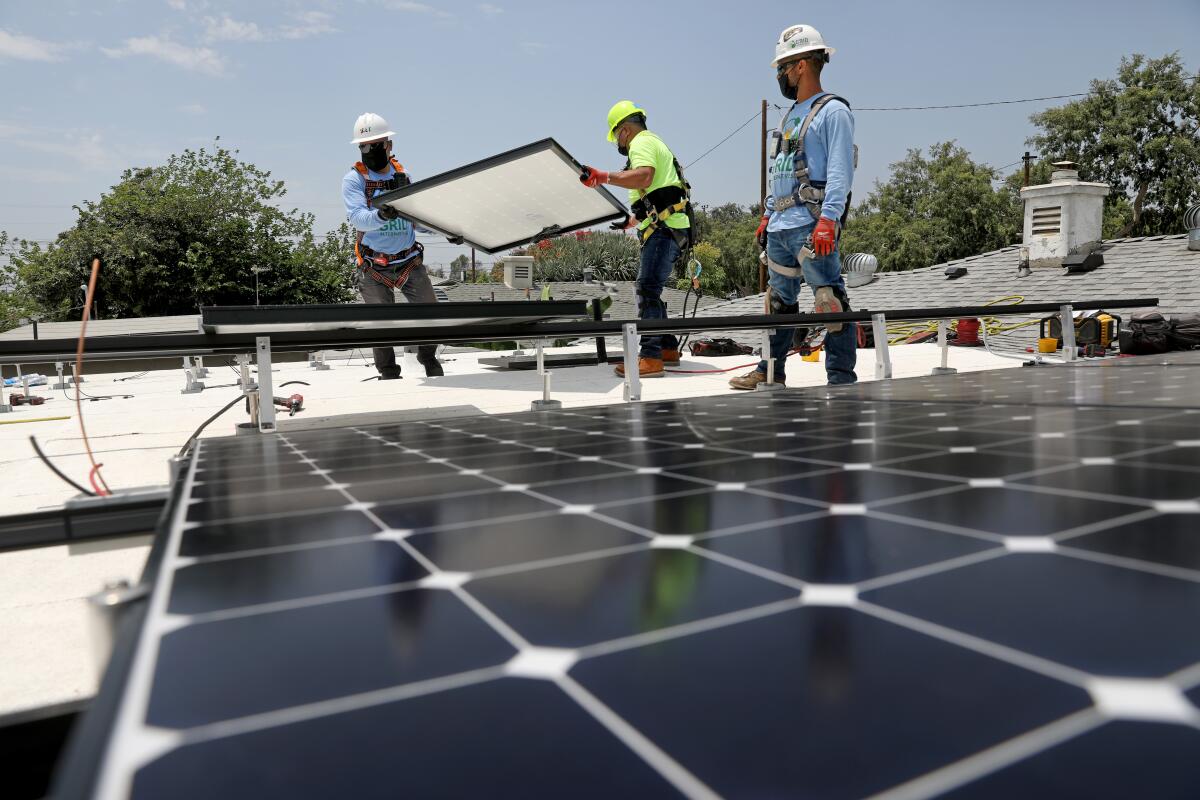
In Pizarro’s telling, the problem with net metering isn’t that it encourages rooftop solar — it’s that the program is unfair to low-income families, and is actually making it harder for California to fight climate change.
He said subsidy payments to solar-powered homes and businesses are contributing to higher electric rates — high rates that in turn makes it less likely people will invest in electric cars, as well as electric appliances such as heat pumps and induction stoves. Those technologies are crucial to burning less oil and natural gas, two of the fossil fuels driving the climate crisis.
The transition to an ell-electric economy is also crucial to Edison’s business plans — which brings us back to the question of why investor-owned utility companies, in California and across the country, have fought to slash rooftop solar incentives.
Pizarro is correct that utilities don’t make less money if they sell less power. But the less electricity they send to customers from far-flung generators, the less they need to invest in power lines and other infrastructure — which is how they make money.
In California, especially, there’s a growing need for those investments. At Newsom’s direction, officials recently moved to end the sale of most new gasoline cars by 2035. A ban on gas heating in new homes is also on the horizon. Supplying power to tens of millions of electric vehicles, heat pumps and water heaters will require a massive expansion of the electric grid.
It’s a shift that’s badly needed to limit planet-warming pollution. And it stands to benefit electric utilities immensely.
Pizarro was quick to acknowledge the alignment between Edison’s business objectives and the state’s climate plans. But when I pressed him on rooftop solar — the more of it gets installed, the fewer long-distance lines and other profitable machines Edison is likely to build — he continued to insist his company’s efforts to slash net metering aren’t motivated by profits. So much power-grid investment will be needed, he said, that rooftop solar will make a small dent at most.
At the same time, Pizarro argued that high payment rates for rooftop solar power “crowd out other investment.” That’s because Edison’s millions of customers are on the hook for most of the company’s costs, through their electric rates. And state officials will allow those rates to get only so high — meaning Edison’s ability to invest in profitable infrastructure is not infinite.
“Is it bad for our business if things go badly for our customers? Absolutely,” Pizarro said. “And it’s bad for the state.”
Doesn’t that means there’s a connection between Edison’s lucrative business model and its push to cut rooftop solar incentives? I posed the question to Pizarro one last time on the way out the door. He offered a distinction I’m not sure I understand.
“It absolutely lines up with our business objectives. It just doesn’t line up with profits,” he said.
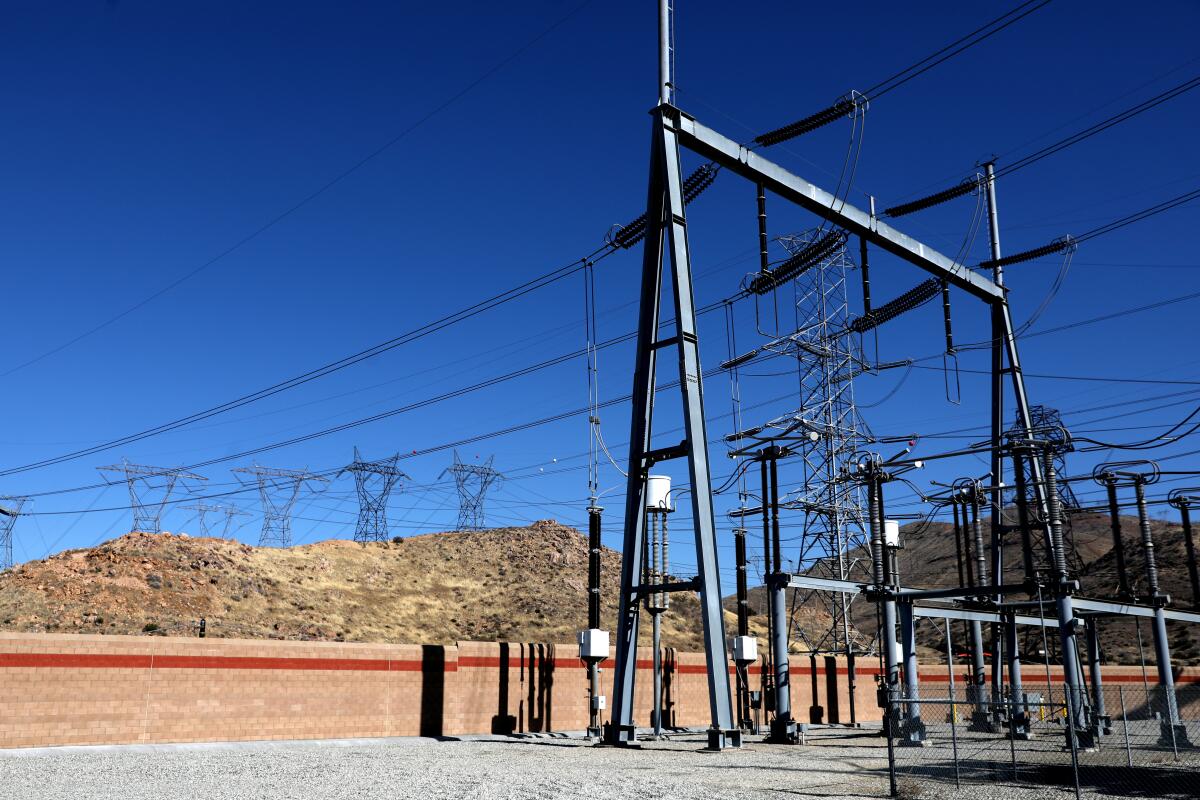
Here’s the thing: We could argue all day about net metering, and it might not matter. Because as I wrote last year, much of the debate stems from a sharp philosophical divide about the best way to respond to climate and environmental calamity.
If you don’t trust Edison and other big energy companies — maybe because of the wildfires they’ve ignited, or environmental damage from the big solar and wind farms they’ve built, or the simple fact that they’re trying to make as much money as possible for their shareholders — you’re probably horrified that California is poised to make rooftop solar more expensive.
There’s research backing that up. A study last year from Washington State University and the University of British Columbia found that Californians who distrust their electric utility “are more likely to be interested in and to have rooftop solar panels.”
Alternately, if you’re less worried about the shortcomings of capitalism — and more interested in using capitalist systems to end the climate crisis — then you may be nodding along with Pizarro. The odds of killing off politically powerful utilities, and replacing them with solar on every rooftop, are pretty low. So why not take advantage of the financial heft they offer?
I can’t tell you how to feel. But I can point you to other analyses concluding that rooftop and large-scale solar are both needed — in huge quantities — to stave off the worst of the climate crisis. Even research funded by the rooftop solar industry and its supporters has found an enormous need for big solar farms, wind turbines and long-distance power lines.
So here we are, one week from the Public Utilities Commission’s high-stakes vote. The outcome is not guaranteed. Opposition from solar companies and climate activists prompted Newsom to quash the commission’s last net metering overhaul.
The governor could step in again — only this time, solar companies and the utility industry are both crying foul.
I’ll have more coverage next week. Until then, here’s what’s happening around the West:
TOP STORIES
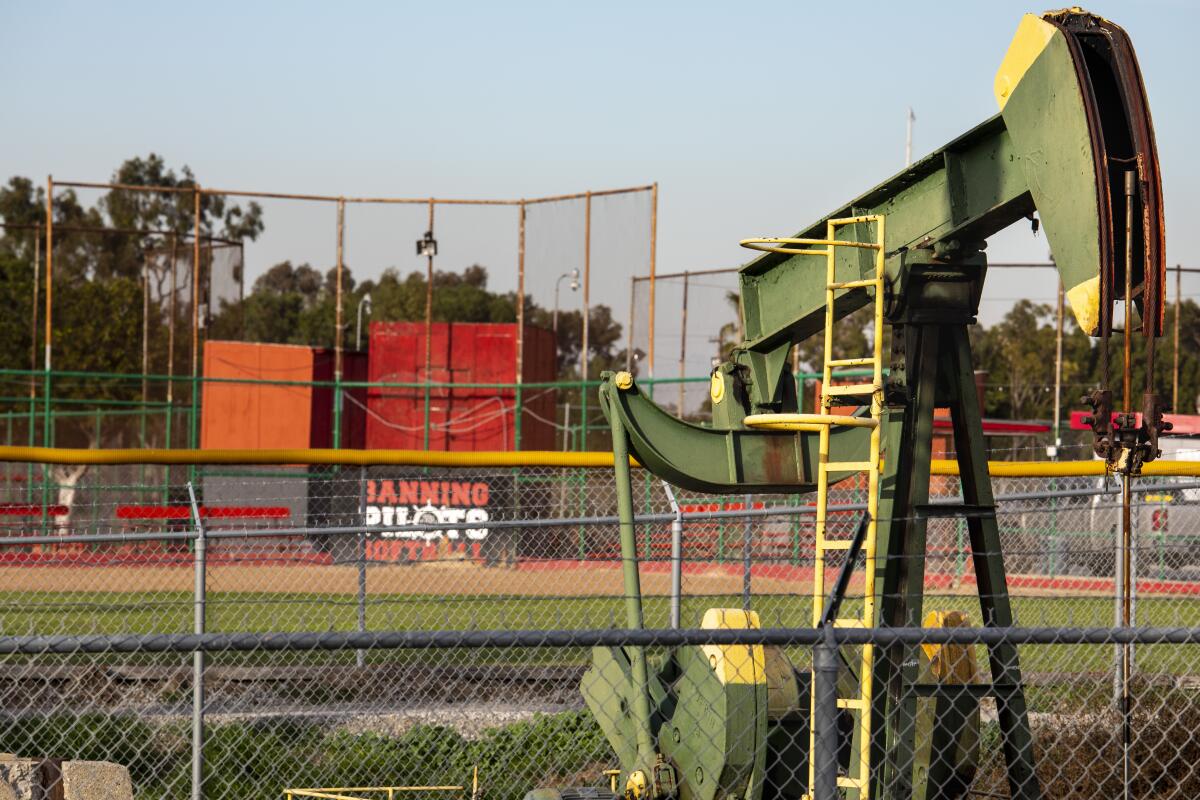
Los Angeles City Council voted unanimously to phase out fossil fuel extraction within city limits — a historic decision for a metropolis built on oil. Details here from The Times’ Dakota Smith, who writes that oil and gas companies must end production within 20 years. Southern California’s air quality regulator, meanwhile, approved a major new smog-reduction plan that includes measures to phase out gas-fueled heaters, furnaces and stoves in homes, as my colleague Tony Briscoe notes in his story. If L.A. and neighboring cities want to encourage electric heat pumps and stoves, they might take some lessons from upstate, where the Sacramento Municipal Utility District is helping low-income households in one of Sacramento’s oldest neighbors transition from gas to electric appliances — at no cost to those people. CapRadio’s Manola Secaira wrote about that effort.
The federal government’s first-ever auction for the right to build floating wind turbines off the California coast drew more than $750 million in high bids. The winning bidders were mostly European companies, Reuters’ Nichola Groom reports, reflecting the reality that Europe is way ahead of America on this technology. Offshore wind could go a long way toward helping California meet its climate goals — but there are still many challenges to be worked through, possibly including century-old requirements for American-built ships, as MIT Technology Review’s James Temple notes in a detailed story.
Gov. Gavin Newsom has released a proposal to cap oil-refinery profits, as the state Legislature begins a special session to deal with high gasoline prices. The Times’ Taryn Luna detailed Newsom’s plan, which would give the Energy Commission broad discretion to adjust the profit cap, investigate violations and issue penalties as needed. Luna also explained the politics at work in Sacramento, where oil companies just spent millions of dollars to help elect Republicans and moderate Democrats favorable to their cause. And my colleague Russ Mitchell wrote about why gas prices are likely to keep rising in California — regardless of what happens in the Legislature — as the state moves toward a 2035 ban on the sale of new gasoline vehicles.
If California is trying to make it easier to ditch gas-fueled cars, should public transit be free? My colleague Ryan Fonseca — who writes our daily Essential California newsletter — asked L.A. Times readers that question, and shared what they had to say. An overwhelming majority of respondents said it’s the right idea, with some of them citing the urgency of the climate crisis.
POLITICAL CLIMATE
Democratic congressional leaders tried to honor the deal they made with Sen. Joe Manchin in exchange for his decisive vote on climate legislation, and push a “permitting reform” bill through Congress this year. The West Virginia Democrat had hoped to see faster approval for energy projects of all kinds, fossil and renewable. But Speaker of the House Nancy Pelosi and Senate Majority Leader Chuck Schumer were unable to bring permitting reform to a vote, stymied by opposition from Republicans and progressive Democrats, Emma Dumain reports for E&E News. Regardless, the climate bill known as the Inflation Reduction Act is the law of the land — in part because electric utility companies went to bat for it, after years of opposing climate policy. The New York Times’ Eric Lipton wrote a fascinating story on how those utility companies shaped the bill to their benefit.
L.A. City Council finalized a series of ordinances tightening restrictions on single-use plastics and prohibiting the sale of Styrofoam. Details here from The Times’ Gregory Yee; also see Susanne Rust’s earlier coverage for background on the scourge of plastic pollution in Los Angeles. City Council also voted this week to finalize a ban on most gas appliances in new homes, a topic I wrote about when the council took its initial vote earlier this year. In other local climate news, L.A. County’s Board of Supervisors is taking early steps toward reducing flood risks and making disadvantaged communities more resilient, following new research on the potential for devastating floods. My colleague Louis Sahagún wrote about the county’s latest efforts.
“Lula is our only hope. He will help us.” Indigenous communities in the Amazon are ready for Brazil’s new president to follow through on his promises to beat back deforestation. It’s one of the most important climate stories in the world, as Ana Ionova writes for The Times. Humanity’s heat-trapping carbon dioxide pollution is expected to hit a record high this year, per Shannon Osaka at the Washington Post — a reality that makes it more important than ever to keep carbon-sucking forests intact.
WATER IN THE WEST

The Pomo Indian tribes of Clear Lake are urging Interior Secretary Deb Haaland to protect the 12-inch minnow they’ve feasted on for hundreds of generations before it goes extinct. “I have almost zero confidence in state or federal officials to save the chi and our way of life. Of course, a miracle could happen,” Ron Montez, tribal historic preservation officer for the Big Valley Band of Pomo Indians, told my colleague Louis Sahagún. It’s a sad example of the ecological suffering that humans have brought to bear on the planet. So is this year’s record-low survival rate for winter-run chinook salmon in the Sacramento River, as detailed by Damon Arthur at the Redding Record Searchlight.
Californians should brace for another year of brown lawns, tight water restrictions and increased calls for conservation. So writes The Times’ Hayley Smith, in a story about local water agencies being told to expect just 5% of their requested supplies from the State Water Project next year, at least if conditions hold. It’s not ideal, but it’s the reality we live in. And it doesn’t help that state regulators don’t have much ability to prevent literal water theft from rivers. Grist’s Jake Bittle has a wild story about the state’s limited enforcement tools, focused on a guy caught stealing water from the Tuolumne River and bottling it for sale to Starbucks, among other buyers. Seven years later, regulators are still tangling with him in court, as he allegedly steals more water.
The federal government is once again threatening major Colorado River cutbacks if California and other Western states can’t agree to do it themselves by a deadline — just like the deadline that passed in August. Only this time there’s a formal legal process accompanying the threat, per Tony Davis at the Arizona Daily Star. In other interesting Colorado River reporting, Voice of San Diego’s MacKenzie Elmer talked with Imperial Valley farmers who actually want to be charged more for water, because they think it will incentivize conservation and help protect the valley against legal challenges to their water rights.
THE ENERGY TRANSITION
President Biden’s Commerce Department is once again raising the specter of tariffs on cheap solar panels imported from Southeast Asia, which solar installers say would be a disaster for business. The tariffs would be implemented in 2024, which wouldn’t give U.S. companies much time to ramp up manufacturing, Canary Media’s Eric Wesoff writes. (When I asked Biden’s energy secretary, Jennifer Granholm, about the possibility of tariffs earlier this year, she was visibly frustrated, describing them as “friendly fire” on the administration’s clean energy agenda.) In other less-than-ideal news for solar — but arguably good news for human rights — the Wall Street Journal’s Phred Dvorak reports that solar projects across the country are getting delayed due to a shortage of photovoltaic panels, as the Biden administration attempts to cracks down on labor abuses in China.
In Rock Springs, Wyo., the West’s largest coal-fired power plant is moving toward closure — and a California startup wants to build a massive carbon capture project. Inside Climate News’ Nicholas Kusnetz wrote about the startup’s “direct air capture” proposal, which has been embraced by some local residents as a new source of jobs to replace some of what’s being lost with coal — and opposed by others because it would disrupt habitat for sage grouse, pronghorn and other at-risk wildlife species.
The legacy of the Cold War is alive and well across the American West in the form of continued radioactive pollution from uranium mining, milling and atomic tests. That’s the key takeaway from an eye-opening ProPublica investigation finding in part that at least 84% of the country’s uranium mills and related sites have polluted groundwater, and nearly three-quarters continue to pose the threat of groundwater pollution due to inadequate safety measures. Statements like this one made my head spin: “More than 40 million people rely on drinking water from the Colorado River, but [federal regulatory agencies] allowed companies to leak contamination from mill waste directly into the river, arguing that the waterway quickly dilutes it.” I was also deeply moved by this story from the Center for Public Integrity’s Yvette Cabrera about a Navajo Nation activist who spent decades fighting for justice for tribal members stricken by potentially radiation-linked cancer before being diagnosed with lymphoma himself.
ONE MORE THING

Speaking of nuclear power ...
As I’ve referenced in previous newsletters, I continue to make my way through “The West Wing” for the first time, and I continue to be amazed by the TV show’s wildly prescient discussion of energy, climate change and other environmental issues.
This week I watched the 2006 episode “Duck and Cover,” which focuses on a radiation leak and near-meltdown at a nuclear plant in the fictional California city of “San Andreo.” It’s clearly a stand-in for San Clemente, the coastal town just north of the real-life San Onofre Nuclear Generating Station. The real-life plant is owned by Southern California Edison and was shut down just a few years after the episode aired because of — you guessed it — a small radiation leak that led to the discovery of larger problems.
As an energy nerd, I enjoyed that the “West Wing” writers didn’t shy away from wonky concepts; one character explains that most nuclear plants are built close to major population centers because “they lose too much power in transmission.” There are also two uses of the acronym PSI — pounds per square inch! — and detailed discussion of Southern California’s Santa Ana winds.
But mostly, it was fascinating for me to watch the characters debate the merits of atomic energy, especially as Gov. Gavin Newsom and President Biden push to rescue California’s last operating nuclear plant, Diablo Canyon, from closure. The episode features the following speech from the show’s Republican presidential candidate, a veteran senator from California:
“You know why Europe’s greenhouse emissions are so much lower than ours? Nuclear power! Totally emissions-free! You know how many Americans die from oil refinery explosions? From coal soot in the air? Tens of thousands!”
Sixteen years later, nuclear energy proponents continue to make similar arguments. They also continue to face questions about uranium pollution — and about the reality that on the rare occasions a nuclear plant does falter, the results can be devastating.
ACTUALLY, ONE MORE THING
Remember when Florida lawmakers voted to revoke Walt Disney World’s self-governing privileges, in an act of retaliation led by Gov. Ron DeSantis, who was mad at then-Disney CEO Bob Chapek for coming out against Florida’s “Don’t Say Gay” law?
Well, a compromise plan is being crafted that would reestablish Disney’s self-governing rights, according to Christopher Grimes at the Financial Times. One important caveat, though: The company would lose the right to build a nuclear power plant, which it was somehow granted by the Florida Legislature back in 1967.
I wonder if the folks who made “A Goofy Movie” will be disappointed.
We’ll be back in your inbox next week. If you enjoyed this newsletter, or previous ones, please consider forwarding it to your friends and colleagues. For more climate and environment news, follow me on Twitter @Sammy_Roth.
Toward a more sustainable California
Get Boiling Point, our newsletter exploring climate change, energy and the environment, and become part of the conversation — and the solution.
You may occasionally receive promotional content from the Los Angeles Times.




